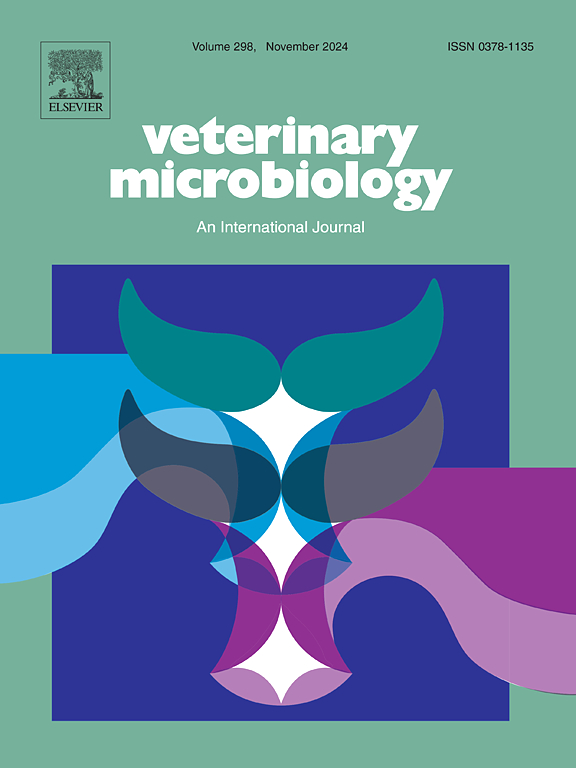EEF1D信号可能通过调节病毒复制区参与牛α -疱疹病毒1型生产感染
IF 2.4
2区 农林科学
Q3 MICROBIOLOGY
引用次数: 0
摘要
牛α疱疹病毒1型(BoAHV1)是影响牛的最重要的病毒之一,给全世界的养牛业造成巨大的经济损失。真核生物翻译延伸因子1δ (EEF1D)是延伸因子1复合物的一个组成部分,在蛋白质合成的延伸阶段起着至关重要的作用。然而,病毒感染与EEF1D信号之间的相互作用在病毒群落中仍然知之甚少。在这里,我们报告了BoAHV1产生性感染导致细胞培养中EEF1D稳态蛋白表达增加。免疫荧光分析表明,MDBK细胞中的多产性病毒感染诱导EEF1D进入细胞核的易位增强,在细胞核中形成特异性斑点,并与病毒蛋白ICP8(病毒复制室的标记物)的斑点共定位。此外,MDBK细胞中的病毒感染使一部分EEF1D在细胞质中重新定位,并与病毒粒子相关蛋白(如病毒蛋白gD)共定位。而EEF1D与病毒粒子相关蛋白的共定位主要在病毒感染的神经- 2a细胞的细胞核中观察到。此外,sirna介导的EEF1D表达下调可显著降低MDBK细胞中BoAHV1的产生性感染。因此,EEF1D与多种病毒蛋白,特别是ICP8(病毒复制室的一个组成部分)的关联可能代表了EEF1D调节病毒复制的潜在机制。本文章由计算机程序翻译,如有差异,请以英文原文为准。
EEF1D signaling contributes to Bovine alpha herpesvirus 1 productive infection, potentially through regulation of viral replication compartments
Bovine alpha herpesvirus 1 (BoAHV1) is one of the most significant viruses affecting cattle, causing substantial economic losses to the cattle industry worldwide. Eukaryotic translation elongation factor 1δ (EEF1D), a component of the elongation factor 1 complex, plays a crucial role in the elongation phase of protein synthesis. However, the interplay between viral infection and EEF1D signaling remains poorly understood within the virus community. Here, we report that BoAHV1 productive infection leads to increased steady-state protein expression of EEF1D in cell cultures. Immunofluorescence assays demonstrated that productive viral infection in MDBK cells induces the enhanced translocation of EEF1D into the nucleus, where it forms specific puncta and co-localizes with the puncta of viral protein ICP8, a marker of the viral replication compartment. Additionally, viral infection in MDBK cells re-localizes a portion of EEF1D in the cytoplasm, where it co-localizes with the virion-associated proteins, such as viral protein gD. While, co-localization of EEF1D with virion-associated proteins is primarily observed in the nuclei of virus-infected Neuro-2A cells. Moreover, siRNA-mediated knockdown of EEF1D expression significantly decreases BoAHV1 productive infection in MDBK cells. Thus, the association of EEF1D with multiple viral proteins, particularly ICP8, a component of the viral replication compartment, may represent a potential mechanism by which EEF1D regulates viral replication.
求助全文
通过发布文献求助,成功后即可免费获取论文全文。
去求助
来源期刊

Veterinary microbiology
农林科学-兽医学
CiteScore
5.90
自引率
6.10%
发文量
221
审稿时长
52 days
期刊介绍:
Veterinary Microbiology is concerned with microbial (bacterial, fungal, viral) diseases of domesticated vertebrate animals (livestock, companion animals, fur-bearing animals, game, poultry, fish) that supply food, other useful products or companionship. In addition, Microbial diseases of wild animals living in captivity, or as members of the feral fauna will also be considered if the infections are of interest because of their interrelation with humans (zoonoses) and/or domestic animals. Studies of antimicrobial resistance are also included, provided that the results represent a substantial advance in knowledge. Authors are strongly encouraged to read - prior to submission - the Editorials (''Scope or cope'' and ''Scope or cope II'') published previously in the journal. The Editors reserve the right to suggest submission to another journal for those papers which they feel would be more appropriate for consideration by that journal.
Original research papers of high quality and novelty on aspects of control, host response, molecular biology, pathogenesis, prevention, and treatment of microbial diseases of animals are published. Papers dealing primarily with immunology, epidemiology, molecular biology and antiviral or microbial agents will only be considered if they demonstrate a clear impact on a disease. Papers focusing solely on diagnostic techniques (such as another PCR protocol or ELISA) will not be published - focus should be on a microorganism and not on a particular technique. Papers only reporting microbial sequences, transcriptomics data, or proteomics data will not be considered unless the results represent a substantial advance in knowledge.
Drug trial papers will be considered if they have general application or significance. Papers on the identification of microorganisms will also be considered, but detailed taxonomic studies do not fall within the scope of the journal. Case reports will not be published, unless they have general application or contain novel aspects. Papers of geographically limited interest, which repeat what had been established elsewhere will not be considered. The readership of the journal is global.
 求助内容:
求助内容: 应助结果提醒方式:
应助结果提醒方式:


